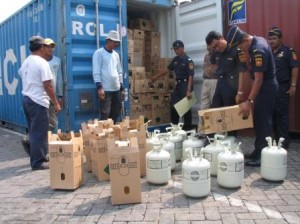We have the chance to nip illegal HCFC trade in the bud


It might have escaped most people’s attention that today, September 16, is World Ozone Day. Or, to put it more long-windedly, the ‘International Day for the Preservation of the Ozone Layer’.
However, it probably won’t have escaped attention that the hole in the ozone layer, the cause of global consternation in the 1970s and ’80s, is on track for (near total) recovery by 2050, or thereabouts. That’s a pretty impressive achievement, and one deserving of careful study at a time when an air of defeatism has begun to pervade UN climate negotiations.

Inspection of a 2004 seizure of CFCs in Indonesia (c) EIA
Like many of my generation, the high-profile campaign to phase out ozone-destroying chemicals was my first encounter with environmental issues and a defining moment in the development of my eco-conscience. I was still at primary school when the international community put their heads together and came up with an agreement to phase out the now infamous CFCs in Montreal; the document that set out just how it was to be achieved is called the Montreal Protocol and it’s hard to keep track of how many times it has received the plaudit of “world’s most successful environmental treaty” in the intervening years, as it has moved from phasing out CFCs to the “second generation” of ozone-depleting substances – HCFCs.
This is not to say that the process has been 100 per cent straightforward, or that there aren’t dangers on the road ahead. One of the most pernicious risks associated with the elimination of CFCs was the illegal trade which sprung up to supply residual demand – and line the pockets of a number of very unscrupulous individuals.
In a series of hard-hitting investigations, EIA documented the criminal profiteering that went on throughout the 1990s and 2000s as CFCs were gradually removed from the global market.
Today, a new report published by EIA and the United Nations Environment Programme (UNEP) LINK underlines the very real threat to the ozone layer posed by illegal trade in HCFCs which, if left unchecked, could seriously hamper the phase-out effort (it could also have a very negative impact on the climate, given that many HCFCs are also potent greenhouse gases). One of the main grounds for concern is the booming production of, and demand for, HCFCs in developing countries where the phase-out has not yet kicked in, and on-going demand and limited supply in developed countries where restrictions have already taken hold.
The report shows that many of the techniques used for smuggling CFCs are now being copied by those involved in the illegal trade in HCFCs (no doubt many of then are the same criminals who were involved first time round). These include false labeling of HCFCs as legal substances, selling fake recycled or reclaimed materials, and trans-shipment fraud in which consignments of HCFCs ostensibly destined for legitimate end markets are diverted onto black markets
So far, so classic. However, as the report points out, what’s different this time around is that we can learn from past mistakes. We now have a wealth of solutions to choose from, including the establishment of licensing and import systems, stepping up of enforcement capabilities and the creation of networks to improve information sharing. As I mentioned in a previous post, the eccentrically named Project Sky Hole Patching has garnered some particularly impressive results.
Needless to say, EIA will be keeping a close eye on developments as the HCFC phase-out continues to unfold. It’s a fairly safe bet that we will continue to see cases of illegal trade cropping up around the world but, as today’s report shows, we’ve now got the knowledge and tools to detect the tell-tale signs of criminal activity and nip it in the bud early on.